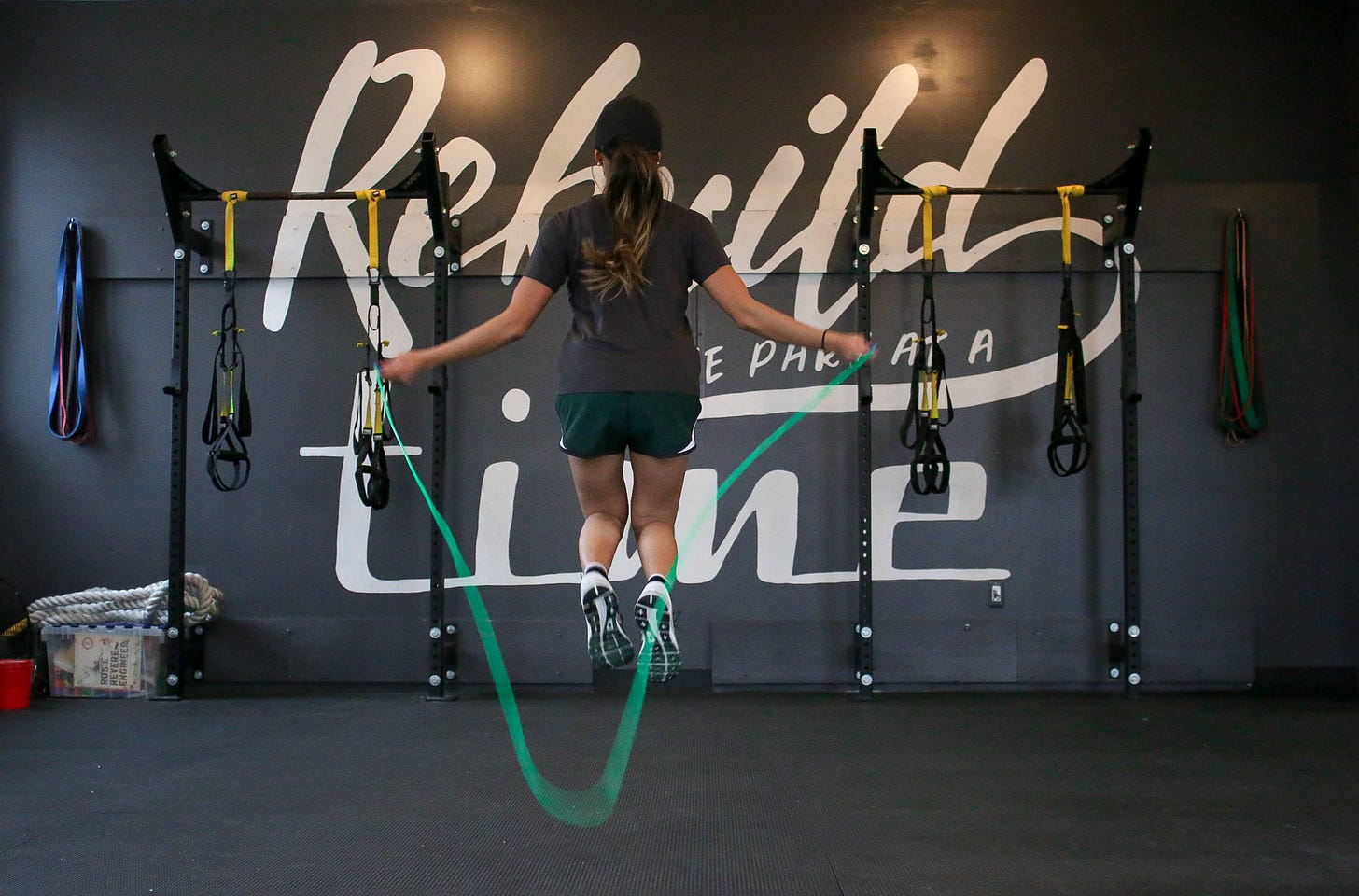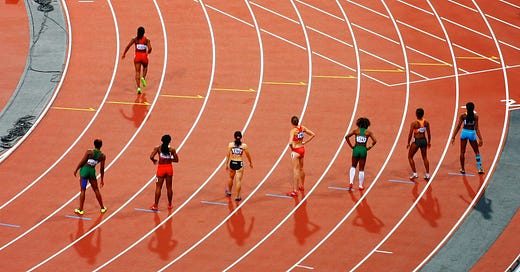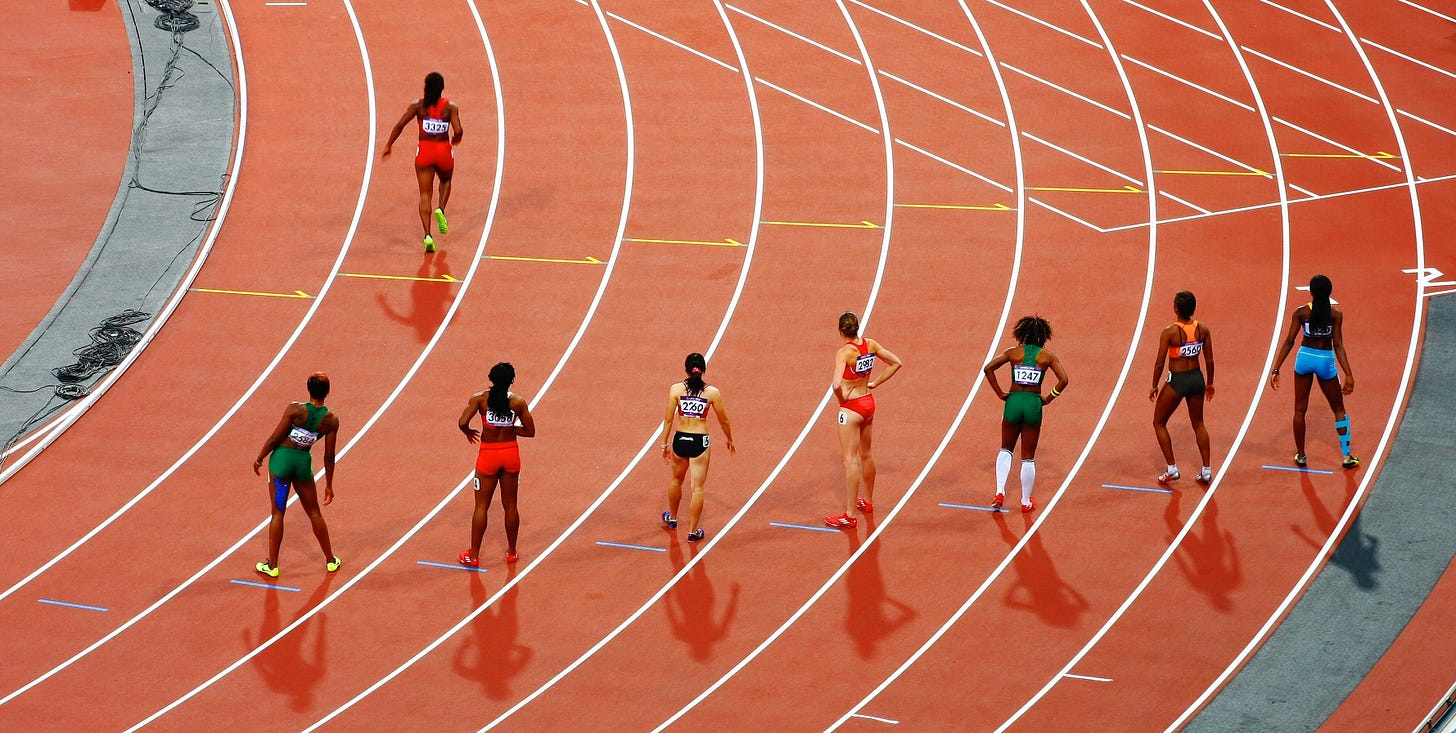Are Cycle Syncing Workouts Worth the Hype?
Seriously, what's the deal with this trend in the fitness and performance space? PLUS a NYC Book Event!
NYC Book Event Update! On Tuesday, April 25 at 6pm, I’ll be talking about Up to Speed with Sara Michael, Group General Manager and Sr. VP at Health. The event is hosted by New York Road Runners. It’s free and you can register here.
PSST! Copies of the book will be available at the event for purchase in advance of its release date on May 16! Come get an early copy!
You can find out about other book events here.
If you ask most journalists, they’ll tell you that they have random Google alerts set up. Usually, it’s a way to stay on top of recent developments in a specific area of interest. Other times, they are random threads or curiosities that could potentially turn into a story.
I have an alert for “menstrual cycles.” I know, but when you report on the intersection of women athletes and sports science research, menstrual cycles kind of become a cornerstone of your reporting. I used to receive an occasional alert but recently, there’s been an uptick in both the number of alerts and the links included in these alerts. Which is great. It means that we’re talking more about cycles and female physiology.
What’s interesting is that more and more of these articles have to do with cycle syncing your workouts.
The general gist behind cycle syncing is that you take into account the different phases of the menstrual cycles (and its corresponding hormone levels) when considering your workout. That’s because hormones like estrogen and progesterone influence more than just your fertility; they can affect metabolism, body temperature regulation, muscle function, and subsequently how you feel when you exercise, how you adapt to training, and how you recover. The theory goes that you may get more bang for your buck doing certain things during a low-hormone phase versus high-hormone phase.
The idea gained attention after the U.S. Women’s National Team won the 2019 World Cup. It was revealed that the players tracked their cycle in the lead-up to the tournament and the media seized on the story, claiming that it was the secret to their success. (Not exactly the full story.)
In the years since, there’s been more interest in menstrual cycles thanks in part to the proliferation of period tracking apps and the greater awareness that specific aspects of female physiology can have very real impact on exercise, training and performance. Mikaela Shiffrin is talking about her cycle. The hashtag #cyclesyncingworkout has roughly 12 million views on TikTok. NWSL teams are changing the color of uniforms kits because of players’ concerns related to their cycle.
Let me say this first: I love that people are talking more openly about menstruation and normalizing these conversations. It’s a key part of our physiology. Why shouldn’t we talk about it like we talk about nutrition or injury risk?
When we pay closer attention to our bodies, we are empowered to make better decisions for ourselves. I also know that for some people, cycle syncing has changed the way that they approach training and fitness for the better and that’s fantastic.
But, if I’m being honest, there’s something that hasn’t sat right with me with the current iteration of cycle syncing.
Cycle Syncing as The Solution
The way I see cycle syncing talked about in the fitness space is that, for a person who menstruates, it’s THE solution to achieving your fitness/training/performance goals.
I get why this is enticing.
After being neglected by the sports science field for so long and constantly having to force-fit ourselves into the male-dominated world of sports and physical culture, it’s validating. Someone is finally paying attention to menstruating people and tailoring programs to our physiology! We want the plan, the solution, that is going to help us perform to the best of our ability. We want it to be easy.
But it often feels like people and brands are jumping on this trend because they see it as a market opportunity. They see this hunger for information and guidance and are capitalizing on it. It also makes the menstrual cycle out to be something you can hack. And it really isn't something you should consciously mess with.
It Feels Diet-Culture Adjacent
Cycle syncing is one more thing that we need to do in order to fit the image of an “athlete” or “someone serious about fitness.” Another way we have to conform in order to be an “active” or “athletic” woman in the world.
But tracking your cycle and taking note of all the symptoms and potential fluctuations on a consistent basis can be a lot of tedious work. There’s a lot of noise to try to sort through too. And frankly, for some, it might not be worth it because some people are less affected by the hormones compared to others.
And what if your hormonal patterns don’t fit into the patterns we’re told they should look like? It’s another way to feel like your body isn’t quite “right.”
It feels like another thing we can overthink and that can get in the way of moving your body in a way feels good to you.
It Makes Hormones the Main Culprit
The other week, I had a really good conversation with Dr. Alyssa Olenick, aka @doclyssfitness, an exercise physiologist at the University of Colorado, and she pointed out that one of the things with cycle syncing is that it makes it seem like hormones are the only thing that matters. As she said to me, we are not defined solely by our hormones and menstrual cycle; it’s not the only thing that will influence how we feel during exercise and training.
Solely focusing on hormones makes it easy to lose sight of the bigger picture and the basics like nutrition, sleep, hydration, and recovery. The reality is that taking care of the basics will likely have more of an impact on how you feel when you exercise and train compared to any hormonal fluctuation you might feel from phase to phase.
Your Cycle isn’t an Algorithm
I’ve said before that I don’t think that the menstrual cycle is a crystal ball. What I mean is that I don’t think that it’s something that you can look at and say on Day 7, do this. On day 15, do that. Rinse and repeat. Yet some of the cycle syncing advice I’ve seen does just that—provide prescriptive guidelines that’s supposed to work for everyone.
No two people have the same cycle or hormonal fluctuations, even if you’re the same age and on the same day of your menstrual cycle. It’s highly individual and it can even change month-to-month and throughout the the lifespan. It can be unpredictable. Paying attention to those individual differences are the cornerstone of any good training program.
Currently, there isn’t a consensus among the research community about whether or not to adapt your training to your cycle. That means that based on the current research, you can’t make a blanket recommendation. However, this largely reflects the current state of the research—the lack of quality research studies, small sample sizes, and limitations in methodology make it very hard to draw general conclusions across studies.
But here’s the part that is hard to capture in a social media caption or news headline. I’m not sure we’ll ever have blueprint guidelines. Scientific studies report on group responses, essentially the average response across a cohort. There are always going to be outliers and we aren’t just data points acting within a controlled laboratory setting. We are complex human beings with a lot of confounding variables that influence our bodies and our lives.

Cycle-Related Symptoms are Real
However, just because a scientific paper says that the research doesn’t suggest that the menstrual cycle affects training or performance doesn’t negate or invalidate the very REAL impact women experience with their cycle.
In order to really understand how your cycle impacts you—and what you can do about—you have to pay attention to YOU. I’ve found it more helpful to think of the cycle like a vital sign—like your heart rate or blood pressure. It gives you a snapshot of what’s going on inside your body. Just like other vital signs, there are things you can do to make sure your cycle hums smoothly every month and to alleviate some of the associated symptoms. More often than not, paying attention to nutrition, sleep, hydration, and recovery can go a long way to keeping your cycle healthy and mitigating some of the troublesome symptoms.
Research studies gives you parameters to play with, but what you do with that information depends on you. It will take trial and error to figure out what works for you, your body, your goals, and your lifestyle. And then testing it over again.
My point isn’t to poo-poo the whole cycle syncing trend. But I just want us to approach it as critical consumers. Ask questions. Look at their advisory board. Look at the research that they are drawing from. Try it out and if doesn’t work for you, try something else just like you’d try a different gel/gu/sports drink if it was upsetting your stomach.
What I’m Reading
Just finished: I Have Some Questions for You by Rebecca Makkai. I am a sucker for a book set at a boarding school (Hi, I went to boarding school) and this was so good. Film professor and podcaster Bodie Kane returns to her alma mater to teach a course and she’s drawn back into the murder case of her former roommate, who was found dead the spring of their senior year. What I really loved was the writing style and the book’s point of view, which was addressed to one of the characters in the novel.
Now reading: Choosing to Run by Des Linden with Bonnie Ford. I’m hoping to finish this before heading up for Boston Marathon weekend. It’s as good as I was expecting. Linden weaves in the story of her 2018 Boston Marathon wins in alternative chapters, which keeps the pace swift and engaging.
“Why Were Two Female Running Champions Killed in Kenya?” in The New Yorker: Full disclosure—I’ve just started reading this piece. It’s long but an important read on a topic that doesn’t get much coverage.
This from
about that weird, ambiguous space before launching a book out into the world:
And this is where I tell you that living my dream of writing a book feels sorta like living my dream of becoming a mother because both dreams were based on nebulous imagery and foolish beliefs in the ability of the external to fundamentally change or improve the internal. Motherhood did not imbue me with radiant strength or peace. Mothering meant that my days and skillset drastically changed but I was shocked to realize that my many human frailties and vulnerabilities remained, despite the fact that I’d attained Madonna status. I fear that being a published author who has written A Book might be the same. Maybe, despite having become this person I’ve dreamed of becoming, I’m still me. Middle-of-the-night anxiety sweats and all.
What I’m Listening To
The Publishing Rodeo podcast: The premise: two authors debuted in the same year, in the same genre, with the same publisher and had dramatically different experiences. In the podcast, they explore the reasons why some books take off, why some don’t, and lots of other insider details. If you’re interested in publishing a book, this is a must-listen, regardless of genre.
Thanks for being here. More soon.
Christine
This newsletter contains Bookshop.org affiliate links.





